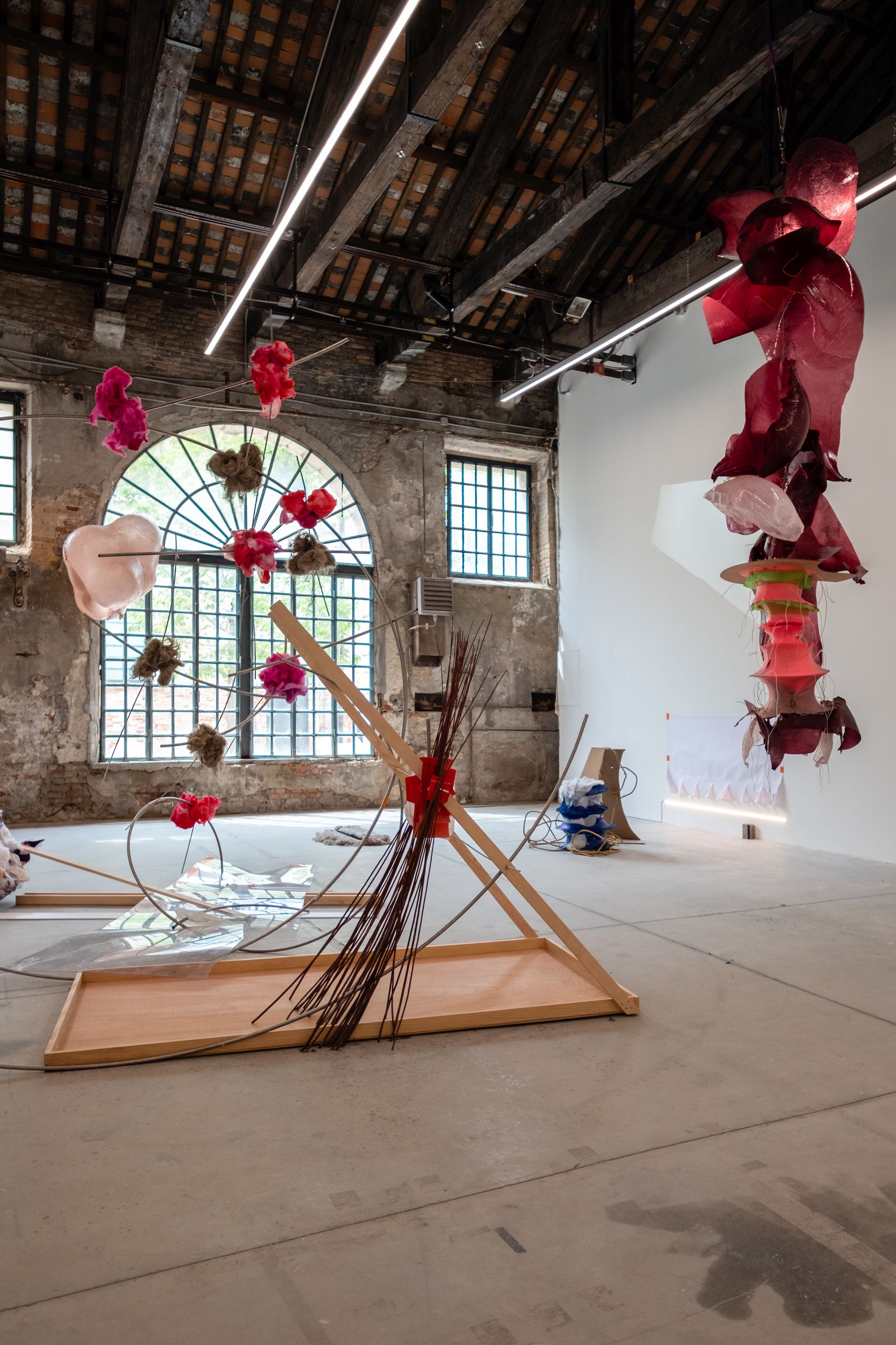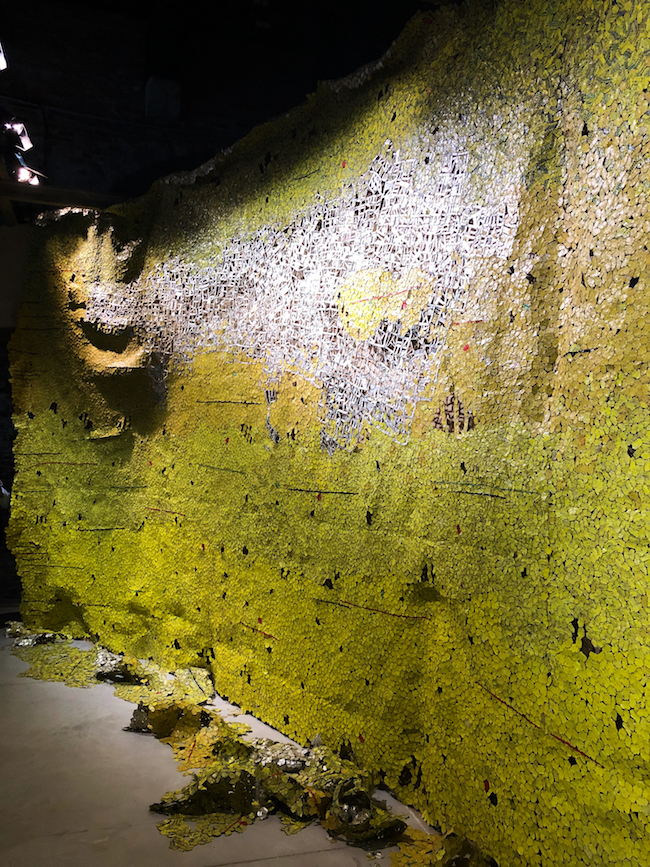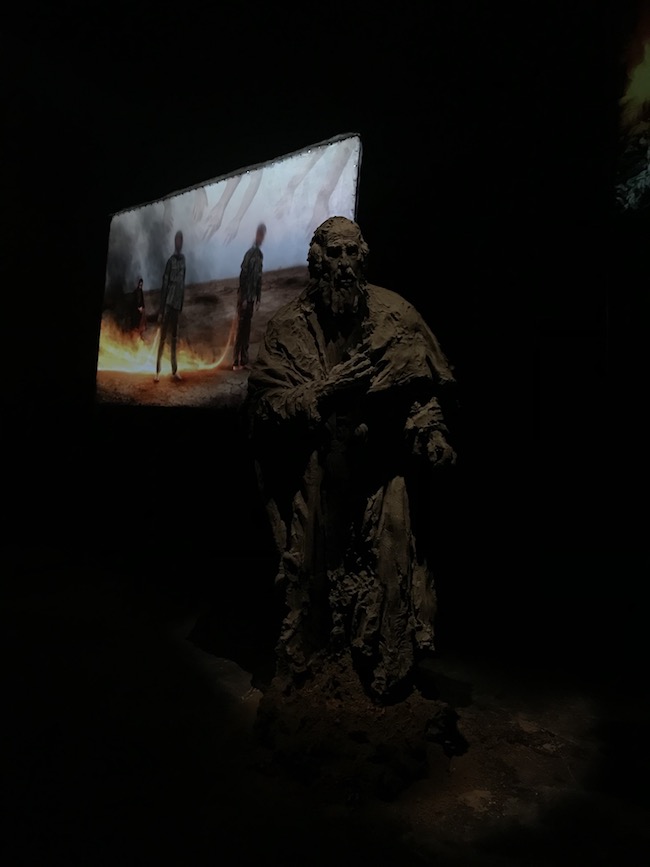
Delving into, rather than comparing
An overview of the national pavilions at the 58th Venice Biennale
23/05/2019
Undoubtedly, the Venice Biennale is one of the most grandiose and discussed biennial events in the art world. It can create tension and dissonance of ideas even among those inhabitants of the planet who normally pay little attention to the field of art. Thanks to its incredible scale and significance, the Biennale has come to mirror trends in art as well as accent current social and human problems around the world; in fact, it is often compared to the Olympic Games.
While the analogy may seem quite absurd to those art enthusiasts who don’t go anywhere near sports, it is nevertheless apt. Alongside the curated exhibition at the Arsenale and the Giardini delle Biennale, an essential (and perhaps even the central!) part of the event is the national pavilions, whose main function is the contextualisation of the selected artist’s work at the level of national belonging. Since the Biennale’s inception in the late 19th century, one of its overarching objectives has been to promote international artistic interaction. The construction of the first national pavilions in the Giardini began already in 1907 (for more information, see Marco Mulazzani’s Guide to the Pavilions of the Venice Biennale Since 1887, which is on sale at the Biennale venues). The Arsenale became the second official venue of the Biennale in 1980. And each year more and more national delegations are choosing to integrate their pavilions into the urban environment both in Venice’s historical centre and beyond.
The 58th Venice Biennale, curated by Ralph Rugoff and subtitled “May You Live in Interesting Times” stands out not only for its reinvigoration of the political art of recent years by focusing on a number of social issues, but also for the record-breaking number of female artists involved. As if intentionally “following the trend”, the three Baltic states have also chosen to be represented by talented young female artists. This has particularly paid off for the Lithuanian Pavilion and artists Rugilė Barzdžiukaitė, Lina Lapelytė and Vaiva Grainytė, who won the Golden Lion for their opera performance Sun & Sea (Marina).
Do not misunderstand, however: the awarding of prizes at the Venice Biennale is in no way linked to gender. Instead, it is linked only to artistic quality, which, with 89 different nations competing, is no easy task for the jury to judge. Although the Lithuanian pavilion and the performance therein have earned global mega-publicity since the very opening of the Biennale, this seems impossible to ignore when again referring to Venice’s international art exhibition. And it seems especially important when viewed from the perspective of a resident of the Baltic region – of course, the awarding of the main prize to your neighbouring country motivates you to get your own act together, but at the same time, it confirms the fact that the most important thing in this game is the work of art itself, not the nationality of its creator or the level of recognition he or she has achieved.
Sun & Sea (Marina) is a truly breathtaking experience that stands out among the other work in this mecca of art with its obvious simplicity and the elegance with which it addresses a pressing issue. No less appealing is the fact that the sand used in the performance was brought from Lithuania, and also that the format is open and visitors to the pavilion are invited to join in.

Rugilė Barzdžiukaitė, Lina Lapelytė and Vaiva Grainytė, Lithuanian pavilion. © Neon Realism
In a way, one can also physically “step into” this work of art through the Latvian pavilion, where artist Daiga Grantiņa has created the site-specific installation Saules Suns. Although she moved away from Latvia when still only a child, Grantiņa is the first female artist to represent Latvia in Venice with a solo exhibition. In it she searches for answers to a variety of questions related to the sense of belonging and also continues her theme of materialising light. The period during which she created this work of art was very emotional for Grantiņa (within just a few minutes of learning that she had been selected to participate in the Biennale, she found out that she was pregnant), and this is reflected in the artwork as well, in which fine lines intermingle with combinations of various brutal materials. Viewers entering the space are literally surrounded by the art – there are no barriers or gaps between them, Saules Suns and the ideas permeating it.

Daiga Grantiņa, Latvian pavilion. Foto Toan Vu-Huu
Like the other Baltic artists, Kris Lemsalu of Estonia is already quite well known to international audiences, and therefore the crowds outside the Estonian pavilion on opening day surprised no one. This time, the artist-provocateur who often addresses the theme of death in her installations and performances switched gears to focus in an extravagant way on love. Life and creation are linked by the concept of love, and Lemsalu emphasises this through a shamanistic physicality in the form of expressive, kinetic vulva-shaped objects. By using such a trivial form to address the creation of life, Lemsalu nevertheless attracts society’s attention and poses questions about who we are, where we come from, where we are headed, and what’s love got to do with all of that.
A different treatment of love is provided by Bárbara Wagner and Benjamin de Burca in the Brazilian Pavilion. There, at the far end of the Giardini, a pleasant break from the seriousness of the Biennale’s themes and an injection of vitality called Swinguerra awaits visitors. The first and smaller of the halls contains bright, large-format photos of stylishly dressed young people in dance poses. But the main attraction is the video shown further inside. In something between a concert video and a documentary study, the artists focus on a popular Brazilian dance phenomenon performed by a group of amateur dancers. The men and women exude enthusiasm, sex appeal and confidence with their synchronous and energetic movements to the rhythmic Latin music. From time to time their performance is interrupted by poetic documentary interludes. The film is presented as an installation, on two screens facing each other. The action on one screen sometimes matches and sometimes differs from that on the other screen, so viewers cannot remain passive and are forced to at least turn around along with the music.

Bárbara Wagner and Benjamin de Burca, Brazilian pavilion
A diametrically opposed mood overwhelms the Russian Pavilion. For those who saw Grisha Bruskin’s exposition Theatrum Orbis (or, a ghastly journey into the iconography of Russian contemporary art) at the Venice Biennale in 2017, this year’s Lc. 15:11–32 exhibition curated by Hermitage director Mikhail Piotrovsky may seem like a logical continuation. With a title that alludes to the Gospel of Luke and the Parable of the Prodigal Son, the Russian Pavilion invites viewers to turn their attention to the themes of religion and history.
The entire pavilion is drenched in a deep, Rembrandt-like darkness with only a few dramatic details highlighted. As usual, the exposition is set out across two floors. On the second floor, where visitors first arrive, they encounter video projections and works of art displayed in the darkness. Notable Russian film director Alexander Sokurov created the concept for this floor with contributions from Elena Zhukova, Lydia Kryukova, film director Alexander Zolotkhin and students from the Saint Petersburg Academy of Art. The first thing visitors see are huge feet – a fragment from a sculpture by one of the Hermitage’s entrances. These are followed by videos of suicide bombers, Christ as portrayed by Ivan Kramskoi, and other no less effective images. The students have created clay sculptures that confirm the vitality of the classic art education in Russia. As visitors climb down to the first floor, the exposition takes on a sarcastic character. Created by scenographer and visual artist Alexander Shishkin-Hokusai, the exposition includes paraphrases of Rembrandt’s paintings on plywood and kinetic dolls that move noisily up and down.
Despite the gloomy mood (or maybe because of it?), opinions of the Russian exposition are divided – some gush about the seriousness of the theme, others say it has too much pathos and call it anachronistic. However, the development of the pavilion is consistent, and also this year the Russian artists and curators have managed to attract interest.
Since time immemorial, the language of art has been a way for intelligent, similarly thinking people to communicate. In spite of various ideological or social barriers, visual art can serve as a bridge in creating a dialogue. This verity can also be applied to the newcomers at the Biennale, Madagascar and Ghana. Both African nations have attracted attention with the appealing scenography of their pavilions.
Russian pavilion
The Madagascar Pavilion, titled I Have Forgotten the Night, was created by Paris-based artist Joël Andrianomearisoa, whose interdisciplinary works in paper have already previously earned the recognition of art professionals. With his work, Andrianomearisoa explores perceptions of reality and their relation to the concept of time; at the Biennale, however, he concentrates on the symbiosis of various Madagascan traditions, such as folklore, literature, art and architecture. The installation is made of thin black paper and brings to mind the uniqueness and fragility of night.
Ghana’s pavilion, on the other hand, delights viewers with its monumentality and spatial solution. Organised by notable architect Sir David Adjaye and curator Nana Oforiatta Ayim, the pavilion features the work of six Ghanaian artists of different generations: Felicia Abban, John Akomfrah, El Anatsui, Ibrahim Mahama, Selasi Awusi Sosu and Lynette Yiadom-Boakye. Through a variety of expressions, these works of art reflect on the importance of freedom in the contemporary world. The title of the exposition, Ghana Freedom, is undeniably a socio-political move that confronts the continuing problems between the West and the rest of the world; however, the desire to see the Ghana Pavilion as separate from the global context prevails and allows one to enjoy the art for its own sake.
The architecture of Adjaye’s exposition recreates a traditional Gurunsi home and does not encourage any thoughts of conflict, incongruity or a clash of ideas as this traditional and untamed sphere “enters” the Venice Biennale. On the contrary, the pavilion attracts visitors with its genuineness and represents a nation’s art in a conceptual way.

Ghana pavilion
On the whole, the Biennale contains several surprises. For example, the formerly award-winning German Pavilion surprises with its simplicity and emptiness. One might wonder whether the exposition has not yet been set up, or has already been dismantled, or is not yet finished. The monumental building (built in 1909 and reconstructed in 1938 by Ernst Haiger) is almost empty; all one sees is scaffolding and a pile of empty fruit crates. The prop-like rocks and puddle are almost disgraceful in terms of their quality. Speakers are located amongst the scaffolding, and the exposition is more audial than visual.
The German Pavilion is curated by Franciska Zólyom, and the artist is Natascha Süder Happelmann, about whom we known that she was born in Iran and her real name is similar but different (Natascha Sadr Haghighian) and that she accepted the pseudonym because is sounds more German. This gesture is intended to criticise nationalism but also to tear down the borders between Western and Eastern traditions. It is not known what Happelmann looks like, because she appears publicly wearing a large “rock” that obscures her head; she did so at the press conference for the German Pavilion as well, thus creating additional intrigue. The content of Ankersentrum (Surviving in the Ruinous Ruin) is a political message related to the refugee issue. Perhaps its ascetic form is the only way that remains in this visually oversaturated Biennale to express political opinions without obvious insincerity.
But the British (artist Cathy Wilkes, curator Zoe Whitley) and French (artist Laure Prouvost, curator Martha Kirszenbaum) pavilions also surprise visitors with their lack of absurd insincerity. In the case of Great Britain, Irish artist Wilkes has experimented with various forms and materials to create a light-filled space open to interpretation. The content of her work revolves around love, the essence of nature and things, and the coexistence of love and death, but it also focuses on the significance of dematerialisation today – not only in art and cultural processes but also in the current social environment. French artist Prouvost has also worked in a somewhat similar fashion. Her exposition Deep See Blu Surrounding You examines three themes, addressing the concepts of generation and identity, language and the appropriation thereof, and escapism to the ideal place. Needless to say, at the Biennale’s opening it was precisely the French Pavilion that received the most visitors (with a queue up to two hours long), and it was also predicted to win the exhibition’s main award.
.jpg)
British pavilion
The Belgian Pavilion – winner of the special jury mention – is completely in the hands of the artist duo of Jos de Gruyter and Harald Thys, with Anne-Claire Schmitz as curator. In this very first national pavilion built in the Giardini delle Biennale (1907, architect Léon Sneyers), they have set up an interactive installation filled with sculptures of human forms – moving dolls dressed in historical costumes. The group in the middle of the pavilion includes a musician, shoemaker, seamstress, knife grinder and other characters that look like they’ve stepped out of a book of folk tales and which the artists have selected to represent stereotypes of traditional society. The smaller spaces of the pavilion are separated from the large hall by painted bars and are filled with characters that are much stranger and do not fit into society: a poet in a long coat, a woman whose head faces backwards, and so on.
The scene looks like an insane asylum from the past, only cleaner and reflecting the Flemish sense of humour in which serious content is mixed with coarse jokes. According to the artists, this exhibition could fit well at an amusement park or a stand marketing a country, but it is nevertheless a critique about the inevitable decline and decay of the Europe of the past. The longer one spends in the pavilion, the more confusing the bars become – which of us are in fact behind bars, who’s being held prisoner? In its motivation statement regarding the special mention, the Biennale’s jury wrote that the Belgian artists have managed to not only discuss under-recognised aspects of social relations in an alternative way; they have also created parallel worlds while working in several visual registers.

Jos de Gruyter and Harald Thys, Belgian pavilion. Foto Nick Ash
The whole idea of national pavilions can be attributed to the assumption of creating several parallel worlds. It is almost impossible to equally evaluate or to speak about an absolute, definite overarching theme regarding the pavilions, because each of them must be appreciated as a mini-exhibition. Each individual pavilion could perhaps be evaluated in how it corresponds to Rugoff’s Biennale theme; however, as we know, art is most often perceived and evaluated subjectively, and so this formula also does not fit the bill for a general evaluation. It is therefore most sensible to simply delve into the enchantment of each pavilion in and of itself (or, depending on one’s personal views, not surrender to that enchantment), refraining from a general comparison of parallels.
